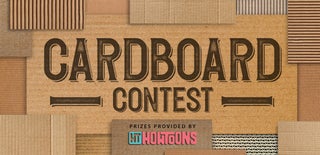Introduction: Star Trek Cardboard Shutttlecraft
A few years back my son inherited my old playmates Star Trek figures. Since then it has been a model building journey. Eventually I built an entire Star Trek play set. ( The bridge can be found here on Instructables) The whole thing started when my son had me cut holes in a box and he told me it was a shuttle craft. I got my geek dander up and told him we needed to do the Enterprise proud and make it a little better. So we set out on a weekend project to make a Star Trek shuttle craft out of cardboard.
Materials:
-Cardboard boxes
-Matte board
-Paper masking tape
-Spray glue
-Hot melt glue
-Paint
-PVC tube
-Wood craft beads
-Plastic soda bottle
-Metal paper fasteners
-Obsession
Step 1: Step One: Inspiration
This is the original cardboard shuttlecraft that started me down a long road to building an elaborate wooden playset.
Step 2: Step Two: Measurements
After finding some diagrams on the internet I laid a one inch grid over the diagrams. From there we derived the measurements. There were a few adjustments to allow it to fit on the available material and fit the action figure proportions.
Step 3: Step Three: Nacelle Base
For the base we took a small piece of wood and glued two pieces of PVC on either side. A wood dowel cut at an angle made the rear of the nacelle and a wood ball was the front.
Step 4: Step Four: Outer Hull Sides
The outer hull was three layers. I put the angle on both pieces and then glued them together with spray glue while they they were at their angle. This holds the angle because each layer holds the other in place. The third outer layer is matte board. This has two purposes. It covers the open seam of the corrugated and also makes a pocket for the door.
Step 5: Step Five: Door
For the door I cut a pocket for the door to slide into within the second layer of corrugated. I cut slots on the inside wall and attached tabs to the doors so they could be slid open. By putting the matte board over the door it creates the pocket for the door.
Step 6: Step Six: Finish Outer Hull
Using masking tape we covered all exposed edges of corrugated and reinforced seams and joints. The top was made removable to access the interior.
Step 7: Step Seven: Chairs
Moving on to the interior. Using the corrugated we cut a chair pattern and bent the corrugated to create the chair shape. The chair swivels were created by using brass paper fasteners. A little paint covers it all up.
Step 8: Step Eight: Test Fit (play)
A little quick check with the eager crew.
Step 9: Step Nine: Consoles
The front console was built using a thinner corrugated. Small wall computers are made from a thin cardboard also. Masking tape and glue to hold it all together.
Step 10: Step Ten: Paint
Everything gets a base paint job using some old house paint. The thick paint covers all the masking tape seams making the tape "nearly" unnoticeable.
Step 11: Step Eleven: Graphics
Using trusty photoshop I created paper graphics. This was a time consuming process. I worked to match the color of the paint so my son could rough cut the graphics out and not have to follow impossible edges. Spray adhesive put them all down.
Step 12: Step Twelve: Console Details
I detailed the interior console with graphics and I used wooden beads to create the personal viewers, and the bottom of a soda bottle became the scanner.
Step 13: Step Thirteen: Rear
A section of wood dowel wrapped with tape for the telescope effect and a cardboard pad makes the strut. The engine is a little curved corrugated.
Step 14: Step Fifteen: Play Time
It is ready to play with. Opening door and the removable roof give full access. We named it "Columbus" because, as my son reminded me, the Galileo was destroyed. Proud geek dad moment.

Participated in the
Cardboard Contest 2017












